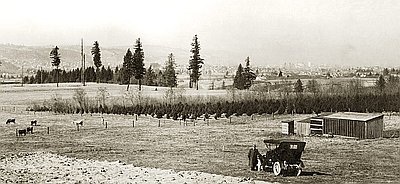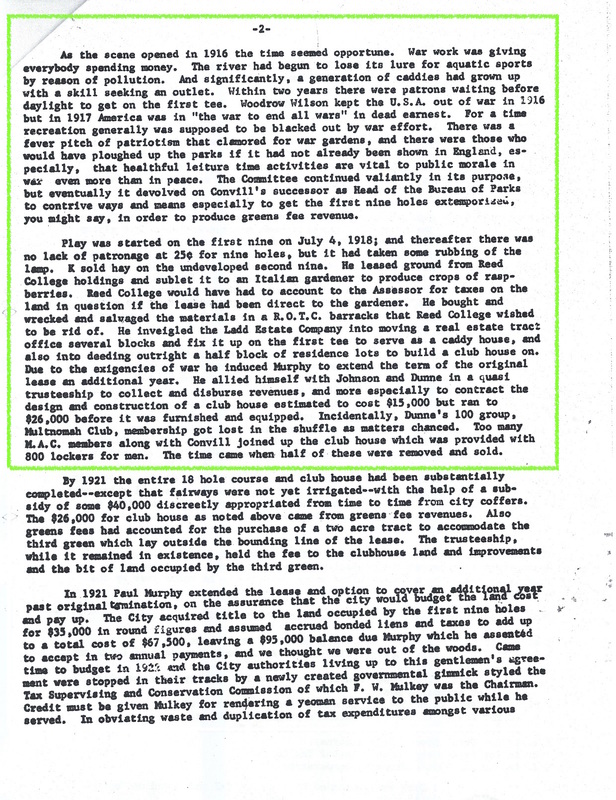 Crystal Springs Farm c.1908 Courtesy Special Collections, Eric V. Hauser Memorial Library, Reed College Crystal Springs Farm c.1908 Courtesy Special Collections, Eric V. Hauser Memorial Library, Reed College "As the scene opens in 1916 the time seemed opportune." - Charles Keyser, Head of Parks & Recreation 1916-1955 With the scene set and all the players accounted for in our last post, Keyser provides the backdrop of the initial building of the Eastmoreland. Pollution of the river depressed the public's appetite for aquatic sports, so Keyser sees municipal golf as an alternative recreation. With the golf boom is just underway and by 1914 municipal golf courses are in vogue with Jefferson Park in Seattle and Lincoln Park in San Francisco, so the Portland is in a race to catch up. The U.S. is not yet officially entered WWI though demand for war supplies in Europe means the economy is bustling and 'everyone has spending money.' It's fairly clear that Keyser is an true administrator, his focus in the background on the economics and logistics of building the municipal golf links. Keyser, for his part, doesn't focus on the political mechanisms - largely because the Committee, led by then Head of Parks Bureau James Convill and his compatriot T. Morris Dunne both leaders from the M.A.C. club. There was quite a bit more politicking both among the city commissioners as well as promotion of the municipal golf links to the public through the local newspapers. Over the course of the summer of 1916, the Committee co-ordinated efforts of public relations and city council to get the official approval in the fall, along with Dunne's 100 group - those who purchased advanced "club membership" to raise the initial capital. What exactly happened for the Dunne 100 to 'get lost in the shuffle' remains unclear, though hopefully more clues can be found in the history of the private clubs, of which many of these group were either a part of - or would go on to found their own clubs. What requires further research is whether there ever was some intent of the Committee to provide for some exclusive play of the M.A.C. club, however the record indicates it was always intended for municipal purposes and public play. Reed College makes the first appearance in the story - having itself been founded on 8 years prior in 1908 - and the old dorm block first opening in 1912. Reed College runs adjacent to Emo's back 9 and separated by 28th Avenue. The college and the golf course do share the beautiful bounty of the Crystal Springs and it's Rhododendron garden. They also shared some early structures as Keyser went about recycling an old R.O.T.C. building and repurposing down the road as a caddyshack. (Portland's Rebuilding Center would give kudos I'm sure!) And for those early years in 1917-1920, the back nine construction was financed in part by income from the Raspberry farms - though I wonder if perhaps some of the luscious blackberry's that line almost every tee box on the back might be remnants of the original berry batch. The repeated concessions by the Ladd Estate Company also begin in earnest, as the 5 year 'free lease' was set to expire in 1921. Get ready for some twists and turns because the ownership and payment for the land will soon become the crux of the issue and put the entire golf links at jeopardy. As the scene opens in 1916 the time seemed opportune. War work was giving everybody spending money. The river had begun to lose its lure for aquatic sports by reason of pollution. And significantly, a generation of caddies had grown up with a skill seeking an outlet. Within two years there were patrons waiting before daylight to get to the first tee. Woodrow Wilson kept the U.S.A. out of war in 1916 but in 1917 America was in “the war to end all wars” in dead earnest. For a time recreation generally was supposed to be a blacked-out by war effort. There was a fever pitch of patriotism that clamored for war gardens, and there were those who would have plowed up the parks if it is not already been shown in England, especially, that healthful leisure time activities are vital to public morale in war even more than in peace. The Committee continued valiantly in its purpose, but eventually it devolved on Conville successor as Head of the Bureau of Parks to contrive ways and means especially to get the first 9 holes extemporized, you might say, in order to produce greens fee revenue. |
|


 RSS Feed
RSS Feed